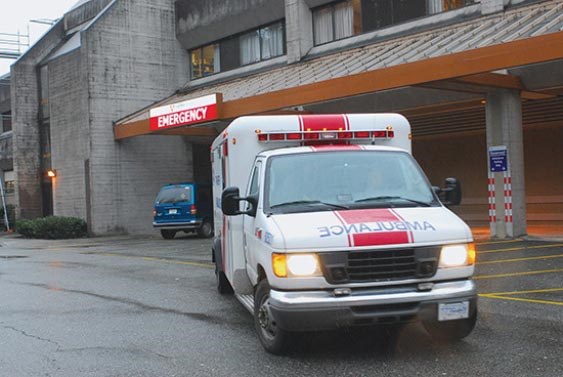A new plan to boost the number of ambulances and paramedics in the Lower Mainland and streamline emergency calls should reduce the waits for ambulances in the Tri-Cities, according to the BC Emergency Health Services (BCEHS).
The changes announced last week come more than a year after Tri-City fire chiefs and mayors complained that it took too long to get ambulance services, causing distress to patients and holding up fire department personnel who attend calls and have to wait for paramedics to arrive.
"There are still too many patients waiting too long for an ambulance who need one and there are too many patients receiving an ambulance and a transport to an ED [emergency department] that don't require it," BCEHS executive vice-president Linda Lupini said of the plan to introduce major reforms.
Although the Tri-Cities won't be getting any of the additional ambulances or paramedics — those will go to areas with high call volume such as Surrey, Langley and Abbotsford — Lupini said this region is expected to benefit because ambulances based in Port Moody and Coquitlam won't have to leave the area as often to assist in life-threatening medical emergencies.
"That should keep calls ready in the Tri-Cities in terms of proximity to call," Lupini said, explaining that under the BCEHS dynamic deployment model, the closest ambulance to the life-threatening emergency is dispatched, often requiring ambulances to leave their jurisdictions.
In fact, as many of 47% calls for service to Tri-Cities-based ambulances come from outside the area, in from cities as Surrey, New Westminster and Burnaby, where hospital emergency rooms are also busy and paramedics often have to wait to be able to release a patient into hospital care.
Lupini said the addition of services in Surrey, Abbotsford and Langley should take some of the pressure off of ambulance services here so emergency personnel can arrive to local calls more quickly.
NEW TARGET FOR WAIT TIMES
The impetus to reduce waiting time comes from an independent review that found it takes an average of 10 minutes and 24 seconds for ambulances to reach life-threatening calls in the Lower Mainland and Greater Victoria.
A new target of under nine minutes for 75% of those critical calls is being adopted, in line with international standards.
The review also warns population growth and aging will drive up call volumes 6% a year and push ambulance response times up to more than 15 minutes by 2020 if no improvements are made.
Lupini said the additional services are an immediate move to relieve pressure, with much more improvement required through a combination of more resources and innovation.
Without changes in procedure, she estimated, up to 30 more ambulances would be required by 2020 and at least 10 single-responder vehicles.
While more money is being requested, many of the planned reforms focus on other methods to speed up ambulance response times to critical calls and to cancel or redirect ambulance transport for less urgent calls that can be handled differently. Lupini said many of those calls "could be dealt with by physicians over the phone or a paramedic seeing and treating a patient without bringing a patient to an emergency room, because that's what really ties up resources."
The top reform priority is to reduce how long paramedics wait in hospital emergency rooms to hand over incoming patients so they can get back on the road. Fraser Health hospitals are expected to be at the forefront of making the necessary ER reforms.
HOPEFUL FOR CHANGE
Still, Coquitlam's mayor is hoping for improvements.
Richard Stewart said a shortage of ambulance puts residents at risk, noting, "I’ve seen those long ambulance waits first hand, and nobody should accept an hour-long wait for an ambulance.
"In southwest Coquitlam, we’re particularly challenged, since there are several hours each day when congestion obstructs the only routes to our closest hospital — RCH [Royal Columbian]. If you can’t get an ambulance quickly and you can’t drive there yourself because of congestion, somebody’s going to die en route to the next-closest hospital," Stewart told The Tri-City News in an email.
He added that the fire department has documented many instances when fire crews were tied up while waiting for an ambulance and that rationing ambulances doesn't save taxpayers' money but simply adds to downloading.
"It’s just the province causing cities to incur more costs."
BY THE NUMBERS
Call locations 2014/’15
• Coquitlam — 7,934
• Port Coquitlam — 4,305
• Port Moody — 1,412
Staffing
• Coquitlam — FT 16, PT 3
• Port Moody — FT 16 PT 4



